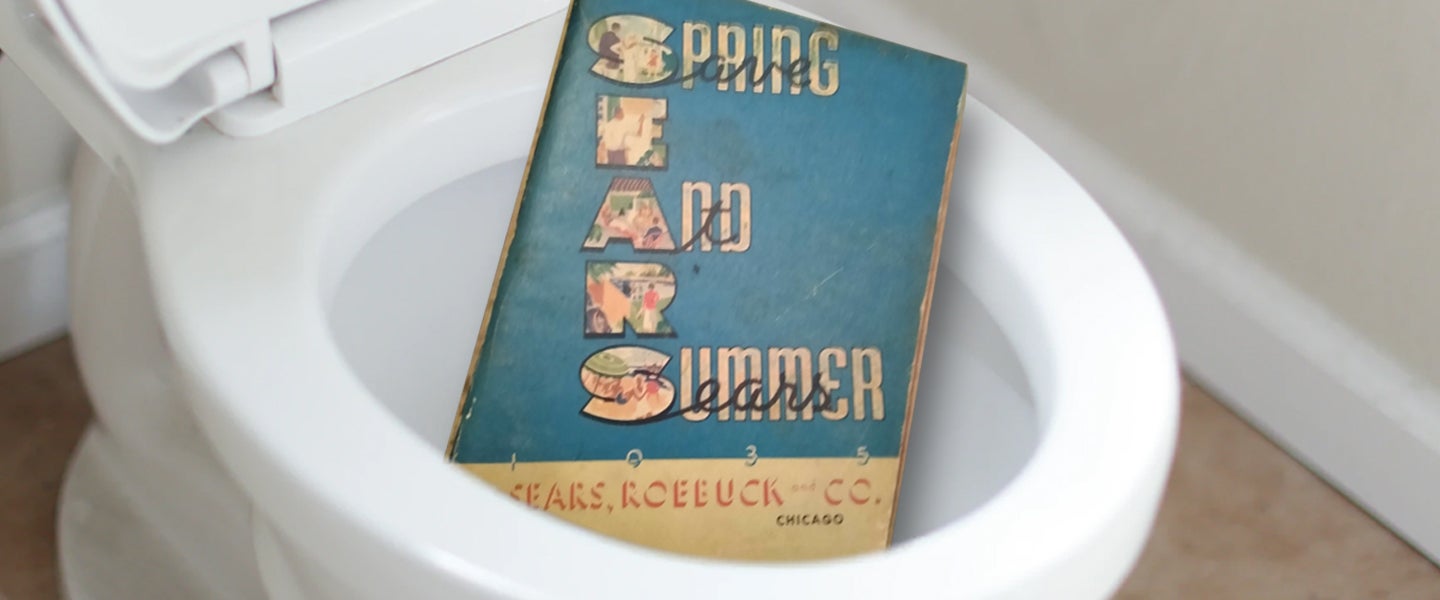In the early 20th century, the Sears catalog was Amazon. Running hundreds of pages, the Sears, Roebuck and Co. catalog made almost everything available via mail order, including essentials like clothing and appliances, as well as nonessentials like banjos and monkeys. They even sold motorcycles and, like, entire houses for a time. Beginning in 1888 and ending in 1993, the Sears catalog served as “a mirror of our times, recording for future historians today’s desires, habits, customs and mode of living,” as the very prescient News Graphic wrote back in 1943.
In some ways, the Sears catalog was actually superior to Amazon. After all, you can’t buy a house or a live monkey on Amazon, and the Sears catalog never took up valuable Wi-Fi. But the Sears catalog also served a purpose Amazon itself could (sadly) never serve — it was once a major source of toilet paper. No, I don’t mean that you could order toilet paper from it — although you could — I mean that pages of the catalog itself served as toilet paper for much of America before toilet paper became mainstream.
At least, that’s the old legend, which I myself have even referenced in my recent history of toilet paper shortages. It not only started in various editions of the trivia book Uncle John’s Bathroom Reader, it was also confirmed by The Farmer’s Almanac (which also served as toilet paper). There’s even a personal essay published in 1980 of an old woman remembering what it was like to wipe with the catalog. But I personally found the most authoritative discovery to be a local newspaper from Axtell, Kansas, which, on September 16, 1937, featured the following excerpt:
“A train load of Sears Roebuck catalogs arrived at the local post office last week. While the bargains therein may not appeal to the public as they did in the past when money was more plentiful, the evident shortage of this fall’s corn crop will cause each recipient to accept the big tome with gratitude.”
This, my friends, is a Great-Depression-era shit joke, with the Sears catalog as a punchline. See, before toilet paper and before the Sears catalog, corn cobs were the most common means of wiping one’s ass. So the joke is that since corn cobs were running low, everyone can wipe their asses with the Sears catalog instead.
This joke, as well as the other accounts, were enough to convince me that the legend is indeed real, which brings me to the real purpose of this story: I was going to relive history by wiping my ass with an old Sears catalog.
I began by browsing eBay, where I found a 1935 spring and summer catalog in very good condition. It numbered 890 pages and cost $45 with free shipping.
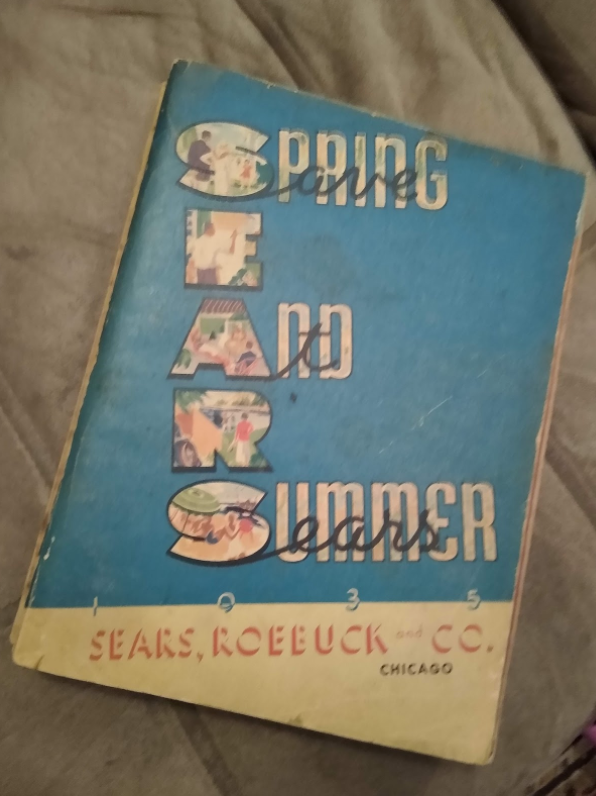
A week later, on April 30th, I got this massive book in the mail. It was in great condition, but its pages had yellowed with age and its spine was a bit worn. Honestly, the book was so well-kept that I felt a bit guilty about what I planned to do with it, and this guilt only compounded when my wife began looking at it and expressed her horror at my assignment. “This book reminds me of my grandma!” she remarked (her grandmother passed when my wife was a teen, and is my daughter’s namesake). Still, I was undeterred, and decided to start the next day with my regular morning shit.
May 1st
On the first day of my trip back in time, I procrastinated for as long as humanly possible before getting up. Those pages didn’t look comfortable in the slightest, so I stayed in bed for nearly an extra hour before heading to the john.
The first few pages in the catalog were glossy, so I decided to randomly pick a section to read and then wipe my ass with. I landed on a section selling fabrics and drapes, all of which looked like a more comforting way to wipe than what I was about to do.
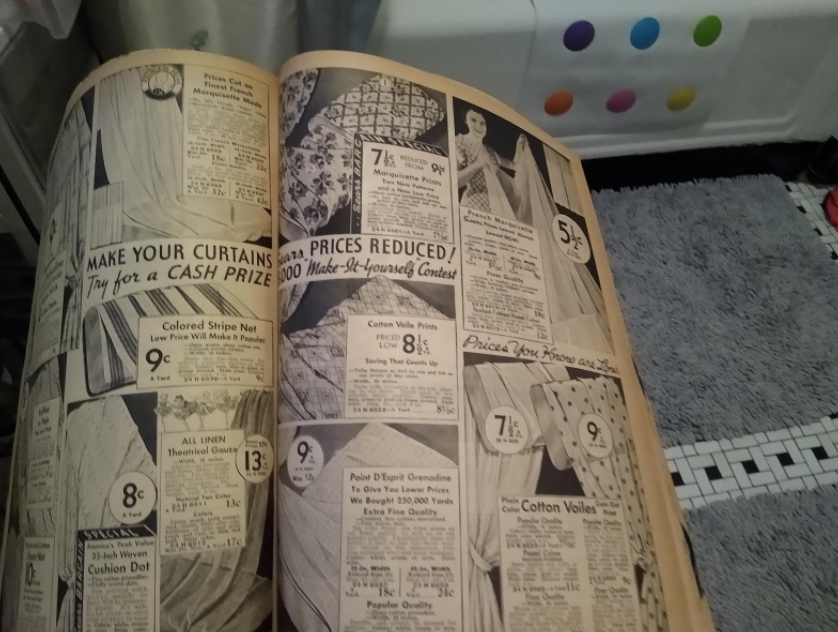
After reading up about Sears’ “make your own curtains” contest, I began tearing out my first page. It tore easily, but the paper had gotten extremely brittle over the past 85 years, so crumpling didn’t work, as that tore the paper even more. Instead, I had to fold it carefully, as just using a straight page without folding tore the paper as soon as I began to wipe.
Upon wiping, the paper felt dry and scratchy against my anus, far more coarse than even the worst public restroom toilet paper. The paper wasn’t absorbent at all, so it took six full pages for me to make sure I got the job done. I also couldn’t flush the papers, as I rent my house and getting evicted during coronavirus for flushing a shit-smeared Sears catalog would be tough to explain to family and friends. So I was forced to put each page in a bag, then take that bag out to the garbage can outside, like I’m a dog who shat on the carpet.
My afternoon trip to the bathroom was much the same as the first. Once again, I procrastinated and when I finally got to wiping, the brittle, cracking paper just about crumbled in my hands. As a father, getting 10 minutes of quiet in the bathroom used to be the highlight of my day, but sadly, this was no longer the case. I used about four or five pages this time and took another bag out to the garbage.
Finding the experience exceedingly uncomfortable and wondering if I was doing something wrong, I call forensic paper scientist Douglas Cobb to find out how this paper may have changed over the years. “Newsprint isn’t a great replacement for toilet paper,” Cobb tells me. “The Sears catalog from 1935 was made from spruce trees. Spruce is a hardwood species that provided an easily accessible and inexpensive supply of paper for the catalog, since the catalog’s intended use is for a rather short period of time. Newsprint is typically groundwood, meaning the wood is ‘ground’ or broken down into its fibers by mechanical means. Spruce groundwood also has the advantage in that it can be used in newsprint, like the Sears catalog, without augmented brightening or bleaching.”
Cobb also explains that wood contains “lignin” which is what “glues” the wood cells together, making them stiff and strong. “Newsprint,” Cobb continues, “still contains the lignin. Some of the lignin molecules are alcohol groups, consisting of oxygen and hydrogen. When lignin is exposed to light and the surrounding air, its molecular structure changes or oxidizes, meaning it takes on additional oxygen molecules. The addition of the oxygen molecules breaks the bond that hold the alcohol groups together, creating chromophores. Chromophores are color carriers that reflect certain wavelengths of light — in the case of newsprint paper, it turns yellow or brown. This is the same reason older books, like paperbacks, yellow with age — they contain groundwood.”
In short, the paper is yellowish and brittle for the same reason — the lignin, or “glue” is broken down, causing it to change color and have weaker bonds in the paper.
During my evening shower — which seemed like a good change of timing, given my assignment — I found a little scrap of paper stuck to my ass and wondered to myself if I really have what it takes to see this thing through.
May 2nd
The next morning as I sat on the toilet, I read up on these really cool-looking gardens in the catalog. Instead of a rigid gardening bed, the garden kind of looked like a carpet that you just rolled out with dirt already in it. Then you placed the seeds in a kind of paint-by-numbers fashion. During quarantine, my wife and I have taken up a bit of gardening, but this seemed way easier. When I wiped, however, the scratchy texture irritated my anus to the point where I saw a tiny bit of blood on the page.

For my later day trip to the john, I decided to test out another thing I’d read online, which served as sort of an addendum to the whole “wiping with the Sears catalog” legend. The story goes that the only reason we switched to toilet paper at all was that in the 1930s, the Sears catalog went glossy, making it no longer suitable for wiping (some versions claim that Sears went glossy precisely so that people would stop wiping with their books). Personally, I have my doubts about this theory. I grew up with phone books in the 1980s and 1990s and they were still newsprint, so I find it a little hard to swallow that Sears would take on a ton of cost in glossing their pages just to dissuade their use as toilet paper, especially considering people would get a new edition every six months anyway.
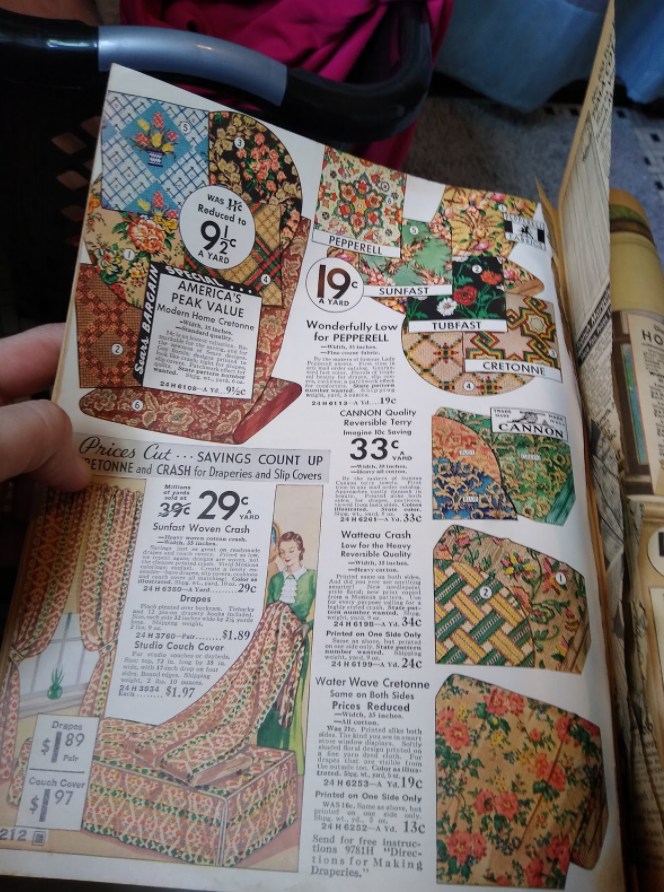
If this tale is true, though, let me tell you, the theory definitely holds up. As I tried wiping with a glossy page, the task proved to be a totally impossible, shit-smearing mess that I immediately regretted.
To deepen my shame, I later disprove the glossy paper story entirely after reaching out to a few eBay sellers offering much later editions of the Sears catalog and asking if the pages are glossy or not. The most helpful answer comes from someone selling a 1966 edition of the catalog, who tells me, “Pages one to 732 are glossy; pages 733 to 1,368 are black and white; and pages 1,369 to 1,683 are glossy.” So that means there would still be 635 pages of newsprint to wipe with as late as 1966, which is well after toilet paper went mainstream.
May 3rd
This morning I found myself engrossed in a suspicious-looking ad for a sewing table, in which Sears admitted/promised, “We can’t tell you the manufacturer’s name — but this is his machine — built to the same specifications and with the same guarantee.” For the life of me, I couldn’t figure out why they wouldn’t be able to reveal the maker of the device, but I resisted the urge to jump down a rabbit hole and find out, as that can sometimes lead me to some really dumb shit.

By now, I was kind of an old pro at wiping with the pages, and then sneaking outside in shame as I threw out my little shopping bag. I did feel a wash of shame come over me, though, when I overheard my wife tell my five-year-old daughter, “That’s Daddy’s special book,” when she asked about the volume sitting next to the toilet.
May 4th
Also, by now, I’ve figured out how to wipe more effectively — i.e., by simply folding two pages together and gently dabbing with page after page until things come up clean. It took more than 10 fucking pages per shit, but at least there was no more blood.
Later, I speak to sexual health expert Evan Goldstein, who specializes in anal issues, to better understand the risk of using such old paper as toilet paper. Like, was there any ancient bacteria on there, or anything else I should have been worried about?
Thankfully, he says that as far as organisms go, I probably had nothing to worry about. The only real danger I faced was from over wiping, which might occur anyway if I didn’t have enough fiber in my diet (which I definitely don’t). “If you’re taking enough fiber and shitting like a dog, most people don’t need to wipe, or they only wipe once or twice just to make sure that they’re clean,” Goldstein explains. “But if someone doesn’t have high fiber content, they will have to wipe and wipe and wipe, and the more that you’re wiping — even with regular toilet paper — the more irritation will arise.”
That irritation can lead to little microtears, which was likely what had occurred to me the day before. Per Goldstein, they’re aren’t too dangerous, but “it’s going to be an itchy, raw ass.”
Lovely.
“Also,” Goldstein continues, “because you’re not getting it as clean as you normally would thanks to the catalog’s lack of absorbency, you might get localized irritation thanks to moisture down there, which can increase the risk of a rash, as well as something fungal or bacterial down there.”
Gross, of course. But I mostly felt validated because his solution was basically what I’d learned by trial-and-error — shower every evening and “blot” more than “wipe.”
May 5th
As I sat atop my throne, I remembered that the Sears catalog once sold mail-order monkeys, which I’d discovered during my probe into the history of cushioned toilet seats. The ad online was from a Sears catalog in the 1960s, but I figured it was worth looking up in this book, too. Unfortunately, I realized that I’d previously torn out pages of the index, so everything in “M” through “Z” was somewhere in a trash can covered in shit, which meant I couldn’t look up “monkeys” or “pets” in the index (there wasn’t a glossary, either).
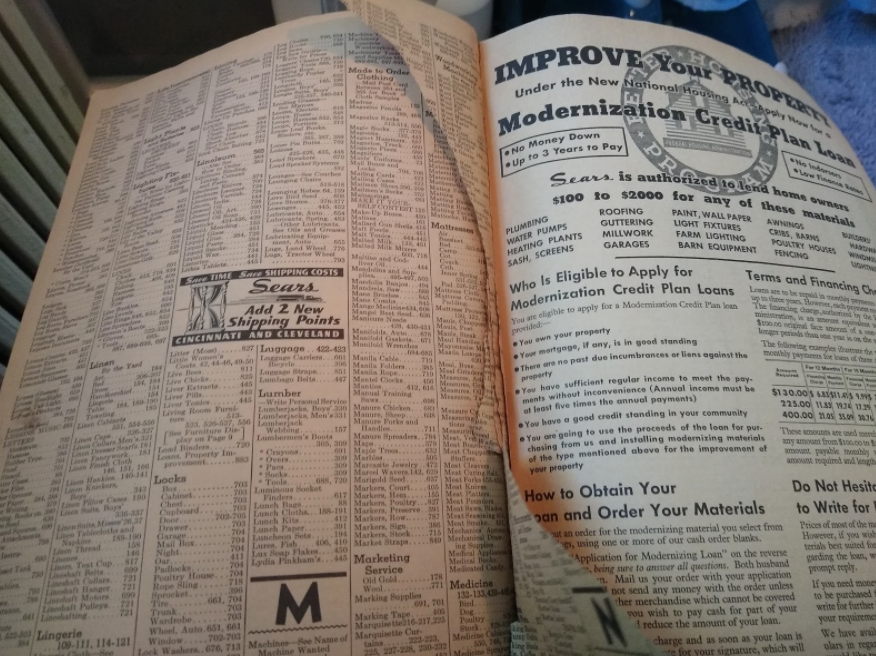
Still, I spent 20 minutes going back and forth through the catalog, trying to find a monkey, but without luck. There were a couple of cows, chickens and horses, but they weren’t for purchase — they were just pictured with various farming equipment for sale.
Afterward, I wiped like an expert, carefully folding the pages and dabbing until nothing was left. Then, per usual, I bagged it up and dumped it outside.
May 6th
I’m actually really thankful to have done this during lockdown, as I couldn’t imagine lugging this stupid fucking catalog around with me wherever I went. The downside of doing it during lockdown, though, was that I couldn’t venture out for fiber supplements. Instead, I began taking antidiarrheal medicine as a preventative measure in the afternoon, not because I had diarrhea, but to harden things up. It just seemed like it would make things a little easier as I entered the home stretch.
May 7th
The last day of my adventure had arrived, and I spent the morning checking out the lingerie section, just to imagine what some other toilet activities may have been like nearly nine decades ago. Frankly, it left a lot to be desired.
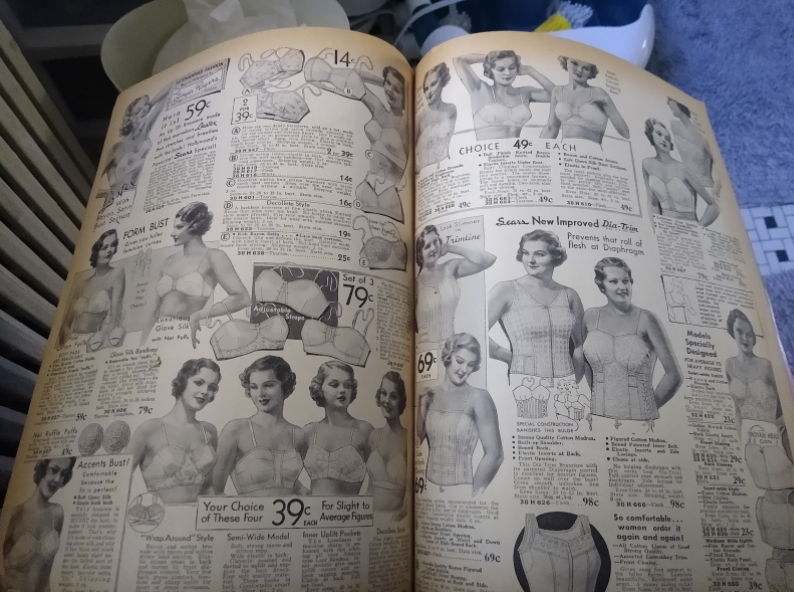
When it came time to wipe, though, it struck me as a bit ungentlemanly to wipe my ass with the faces of these women, so I found a much less shameful page with clocks on it.
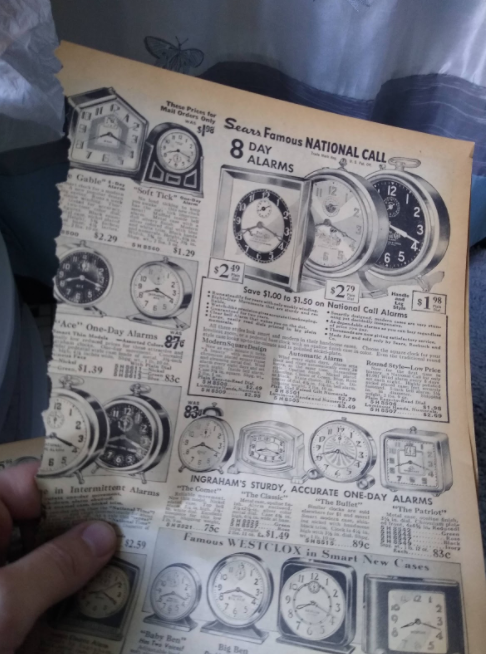
And, since it would turn out that this was the day’s only trip to the bathroom featuring a “number two,” I’d say the selection was fairly perfect. After all, the whole point of this experiment was a bit of real-life time travel to see what things may have been like in the days before toilet paper hit the mainstream.
Sure, it may have been scratchy, uncomfortable and a little bloody, but I feel like I gained a greater respect for my forebears. I also found a greater respect for the historical significance of the Sears catalog, while, of course, also disrespecting it in the most disgusting way possible.
All told, it’s hard to say how many pages I used, but when I was done with the catalog, it looked almost the same as when I’d begun, with probably a good 800 pages left for more wiping.
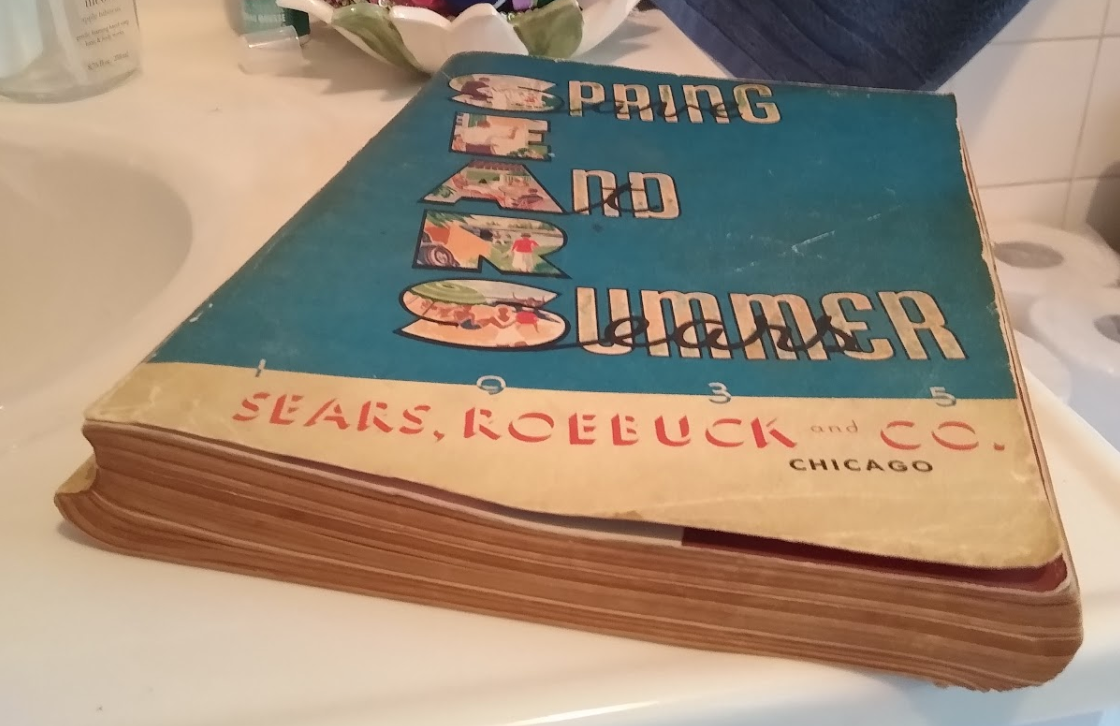
I, of course, won’t be using it for those purposes again — my asshole has already suffered enough — but I feel confident knowing that if we do end up facing an extreme toilet paper shortage, I’ll be better suited to cope than most.
